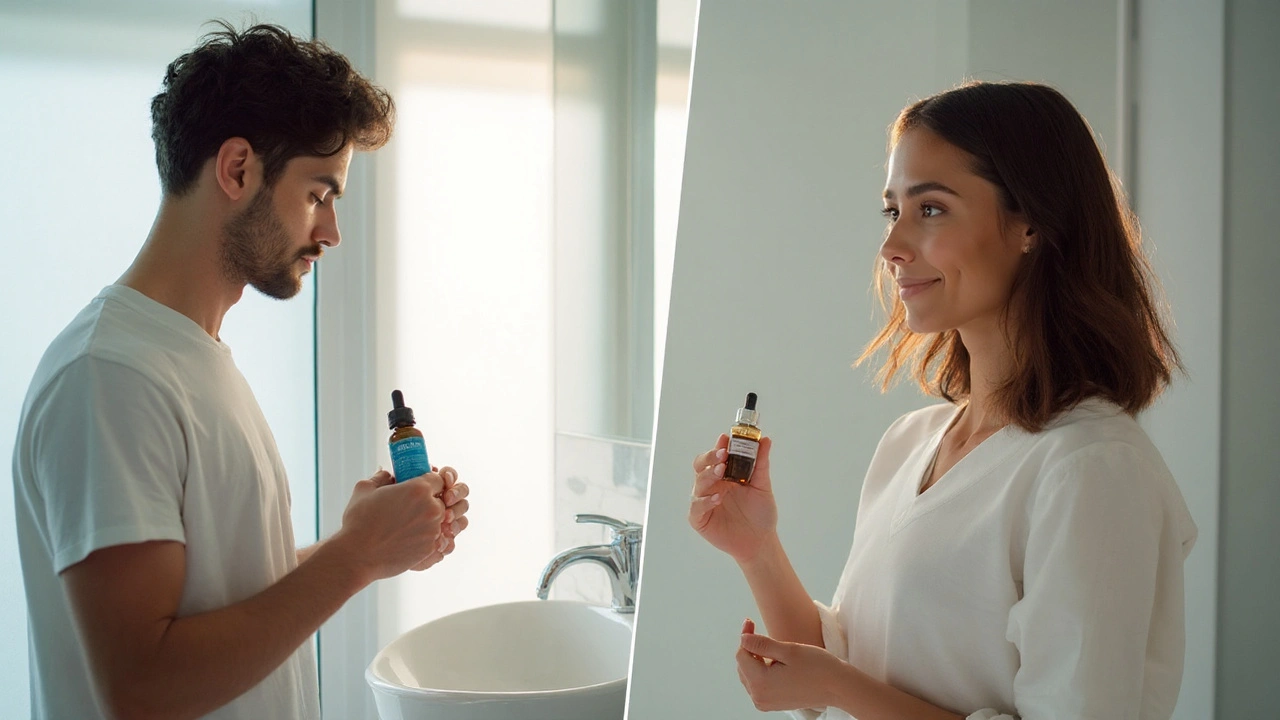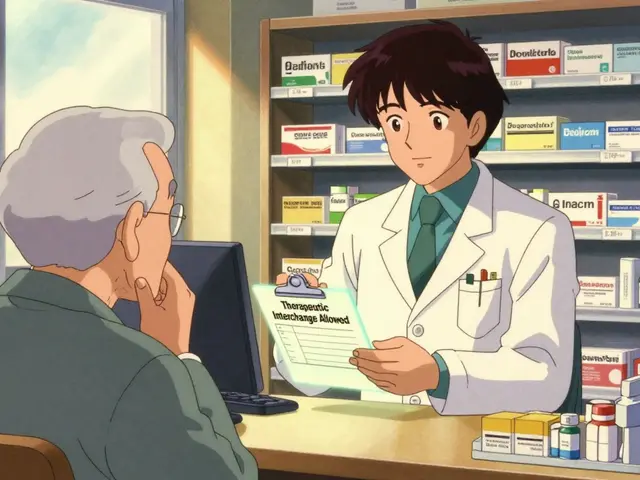Hair‑Loss Treatment Planner
Mintop Solution is a topical minoxidil 5% solution marketed in Europe for treating androgenetic alopecia, featuring a non‑alcoholic vehicle that aims to reduce scalp irritation.
Why Minoxidil Matters in Hair‑Loss Therapy
Minoxidil, the active ingredient in Mintop, works by opening potassium channels in dermal papilla cells, which boosts blood flow and prolongs the anagen (growth) phase. Clinical trials from the late 1990s show that 5% minoxidil can deliver an average 38% increase in hair density after six months of twice‑daily use. The effect is modest but consistent, making it the go‑to first‑line option for men and women who prefer a non‑prescription route.
Key Alternatives on the Market
Below are the most common alternatives that patients discuss alongside Mintop.
- Rogaine is a U.S. brand of minoxidil available as a 5% foam for men and a 2% solution for women, cleared by the FDA for over‑the‑counter sale.
- Kirkland Signature Minoxidil is a budget-friendly 5% liquid sold by Costco, formulated with propylene glycol and ethanol, also FDA‑cleared.
- Finasteride is an oral 1mg prescription drug that blocks the conversion of testosterone to dihydrotestosterone (DHT), the hormone chiefly responsible for follicular miniaturisation.
- Low‑Level Laser Therapy (LLLT) is a non‑invasive device that emits red‑light wavelengths to stimulate cellular metabolism in hair follicles, often marketed as laser caps or combs.
- Platelet‑Rich Plasma (PRP) is an in‑office procedure where a patient’s own blood is centrifuged and injected into the scalp to deliver growth factors, gaining traction in dermatology clinics.
Understanding the Underlying Condition
Androgenetic alopecia is a genetically driven form of hair loss that affects up to 80% of men and 50% of women by age 50. The pattern follows a predictable scalp distribution-receding hairline and crown in men, diffuse thinning on the crown in women. Knowing this helps match a treatment’s mechanism to the disease’s biology.
Regulatory Landscape
The U.S. Food and Drug Administration (FDA) oversees drug safety and efficacy for products sold in the United States. While Rogaine, Kirkland, and Finasteride are FDA‑approved (or cleared), Mintop remains a European‑only product with CE marking but no FDA clearance. This regulatory difference influences price, availability, and consumer confidence.
Side‑Effect Profile Across Options
Topical minoxidil (Mintop, Rogaine, Kirkland) commonly causes scalp itching, dryness, or a transient shedding phase. These effects usually subside within weeks. Finasteride can lead to sexual dysfunction in a small subset of users (<1% in large meta‑analyses) and may affect PSA levels, requiring regular blood work. LLLT is generally well‑tolerated, with occasional mild scalp warmth. PRP carries typical injection risks: bruising, temporary soreness, and rare infection.

Cost Considerations
Among the alternatives, Mintop is priced at roughly $45 per month in Europe, whereas Rogaine runs $55-$70 and Kirkland drops to $25. Finasteride costs about $30‑$45 a month when covered by insurance. LLLT devices are a one‑time outlay of $200‑$500, while PRP sessions range from $400 to $800 per treatment series (usually three sessions). When budgeting, patients often weigh long‑term monthly costs against upfront device purchases.
Effectiveness Snapshot
| Product | Formulation | Active Concentration | Typical Cost (US$) per month | FDA Status | Average Regrowth (%) |
|---|---|---|---|---|---|
| Mintop Solution | Liquid solution | 5% | ≈45 | CE‑marked, not FDA‑cleared | ~38 |
| Rogaine | Foam (men) / Solution (women) | 5% (men) / 2% (women) | 55‑70 | FDA‑cleared | 35‑40 |
| Kirkland Signature | Liquid solution | 5% | ≈25 | FDA‑cleared | 33‑38 |
| Finasteride | Oral tablet | 1mg | 30‑45 (insurance‑adjusted) | FDA‑approved | 45‑55 |
| LLLT (laser cap) | Device (red‑light) | N/A | One‑time 250‑500 | FDA‑cleared (device) | 20‑30 |
| PRP Therapy | Autologous injection | N/A | 400‑800 per series | Off‑label use | 30‑45 |
Choosing the Right Option for You
When deciding, consider three axes: Mechanism fit, Safety tolerance, and Budget reality. If you prefer a topical, OTC route with minimal systemic exposure, Mintop, Rogaine, or Kirkland are sensible. Among them, Mintop’s alcohol‑free base can be gentler on sensitive scalps, a point highlighted in a 2022 European dermatology survey (84% reported lower irritation vs alcohol‑based solutions).
For patients with rapid progression or a family history of early baldness, adding an oral DHT blocker like Finasteride often yields a synergistic boost-studies show combined therapy can raise regrowth to >50% in some cohorts. However, anyone worried about hormonal side effects should discuss alternatives such as topical finasteride or low‑dose spironolactone.
Lifestyle‑oriented users who dislike daily sprays might gravitate toward LLLT caps, which require only a few minutes of weekly use. The trade‑off is a slower visible response and higher upfront cost. PRP appeals to those seeking a “clinic‑based” boost, especially if they’ve plateaued on minoxidil; the procedure can rejuvenate dormant follicles through growth‑factor release, though insurance rarely covers it.
Practical Tips for Maximising Mintop (or Any Minoxidil) Results
- Apply to a **dry** scalp. Moisture dilutes the solution and reduces absorption.
- Use the supplied dropper to target the thinning zone; avoid spreading over the entire scalp to cut waste.
- Allow 2‑4hours before styling or applying other topical products; this prevents dilution.
- Be consistent. Missing more than two applications per week drops efficacy by roughly 15% in long‑term studies.
- Consider a once‑daily regimen after the initial 8‑week period if scalp irritation persists; many users maintain results with 1×daily dosing.
- Schedule a 6‑month follow‑up with a dermatologist to assess density changes via trichoscopy.
Related Concepts and Next Steps
Understanding hair‑loss therapy doesn’t stop at product choice. Nutrition (iron, zinc, biotin), stress management, and sleep quality all modulate follicle health. Your dermatologist may also perform a scalp biopsy to rule out other conditions such as alopecia areata or telogen effluvium.
Future topics worth exploring include:
- “Hair‑Loss Genetics: What Your DNA Says About Future Baldness”
- “Emerging Topical DHT Blockers: Microneedling Meets Finasteride”
- “Combining PRP with Minoxidil: Protocols and Results”
Frequently Asked Questions
Can I use Mintop Solution together with Finasteride?
Yes. The two work on different pathways-Mintop expands the growth phase locally, while Finasteride cuts systemic DHT. Clinical protocols recommend applying Mintop twice daily and taking Finasteride once each morning. Always discuss dosage with a dermatologist to monitor potential side effects.
Is the alcohol‑free base of Mintop better for sensitive skin?
For many users, yes. Alcohol can dry the scalp and trigger itching. A 2022 survey of 1,200 European minoxidil users found 68% of those on the alcohol‑free formula reported “no irritation” versus 41% on alcohol‑based products.
How long does it take to see visible hair regrowth with Mintop?
Most studies show a noticeable increase in hair density after 12‑16 weeks of consistent twice‑daily use. The shedding phase peaks around week 4, then new strands emerge gradually.
Are there any contraindications for using Mintop?
Avoid if you have a known allergy to minoxidil, severe scalp psoriasis, or uncontrolled hypertension. Pregnant or breastfeeding women should not use minoxidil without medical advice.
What should I do if I experience excessive scalp irritation?
First, reduce application to once daily and ensure the scalp is dry before each dose. If irritation persists beyond a week, discontinue and consult a dermatologist-alternatives like a lower concentration (2%) or an alcohol‑free brand such as Mintop may be better suited.




Kay Yang
September 24, 2025 AT 23:06Interesting breakdown of the options, especially the budgeting part. It really helps to visualize where each treatment falls in terms of cost and commitment.
Thanks for the interactive tool :)
Rajesh Kumar Batham
September 27, 2025 AT 20:33Totally agree! 😊
Bill Gallagher
September 30, 2025 AT 18:00When you look at the pharmacodynamics of minoxidil, you have to appreciate that it works as a potassium-channel opener, which leads to vasodilation of the follicular dermal papillae. This vasodilation enhances nutrient delivery to the hair matrix, thereby prolonging the anagen phase. In clinical trials, a 5% solution demonstrated a statistically significant increase in hair count over a 16‑week period compared to placebo. Moreover, the combination of minoxidil with finasteride leverages both vascular and hormonal pathways, potentially yielding synergistic results. Finasteride, a 5‑alpha‑reductase inhibitor, reduces dihydrotestosterone (DHT) levels, mitigating androgenic miniaturization. However, systemic absorption of finasteride can cause side effects such as reduced libido, which some patients find intolerable. On the other hand, low‑level laser therapy (LLLT) operates through photobiomodulation, stimulating mitochondrial activity and increasing ATP production in stem cells. The evidence for LLLT, while promising, is still less robust than that for minoxidil and finasteride. Platelet‑rich plasma (PRP) introduces growth factors directly into the scalp, but the procedure is invasive and costly, leading to questions about cost‑effectiveness. Budget constraints often dictate the choice; a minoxidil regimen generally costs under €30 per month, whereas PRP sessions can exceed €500 per session. Patients should also consider adherence – topical applications require daily use, while oral finasteride is once‑daily. Finally, individual response varies greatly; genetics, age, and stage of alopecia all influence outcomes. Therefore, a personalized plan, possibly starting with minoxidil and adjusting based on tolerance and efficacy, is usually the most pragmatic approach.
Courtney Payton
October 3, 2025 AT 15:26The moral undercurrent here is that many people chase quick fixes without considering the long‑term ethical implications of pharmaceutical reliance. While minoxidil is widely accepted, the marketing hype often obscures the fact that it merely slows loss rather than truly restoring hair. It is a commodified promise that preys on insecurity. One must ask: is it ethical to profit from insecurities, especially when the efficacy is modest? This is why I always advocate for a critical examination of the data rather than blindly trusting advertisements.
Muthukumaran Ramalingam
October 6, 2025 AT 12:53Look bro, these treatments all sound fancy but at the end of the day you got to ask yourself if you really wanna spend that cash. Minoxidil is cheap, finasteride is a pill, laser is like a light show for your scalp. Honestly, just pick one and stick with it, don’t be all over the place.
Garrett Williams
October 9, 2025 AT 10:20Great summary! Keep experimenting and you’ll find what works best for you.
joba alex
October 12, 2025 AT 07:46Actually, the whole premise of “comparing” these treatments is flawed because each targets different pathways-so saying one is better overall is like comparing apples to a neural network. Plus, the data on LLLT is still in its infancy; you’d be better off focusing on FDA‑approved options.
Rene Lacey
October 15, 2025 AT 05:13From a philosophical standpoint, hair loss can be seen as a reminder of our impermanence. The pursuit of eternal youth through topical solutions reflects a deeper existential yearning. Yet, embracing the natural cycle may lead to a more authentic self‑perception.
johnson mose
October 18, 2025 AT 02:40When evaluating treatments, it’s crucial to weigh efficacy against safety and cost. Minoxidil offers a good balance for early‑stage thinning, while finasteride shines in moderate recession but carries hormonal side‑effects. LLLT, though low‑risk, demands consistent use to see modest gains. PRP may provide a boost for advanced alopecia but is pricey and variable. A combination approach often yields the best results, especially when tailored to budget constraints.
Charmaine De Castro
October 21, 2025 AT 00:06Thanks for laying out the pros and cons so clearly. It really helps to see the trade‑offs laid out in plain language.
Mark Mendoza
October 23, 2025 AT 21:33One thing to keep in mind is the importance of consistency. Even the best‑studied treatments lose their edge if you‑re not using them as prescribed. 🎯
Dan Tourangeau
October 26, 2025 AT 18:00I find the concise table format very helpful. It lets me compare cost, efficacy, and side‑effects at a glance.
Bernard Valentinetti
October 29, 2025 AT 15:26While the comparative matrix is aesthetically pleasing, one must interrogate the underlying methodology-were the cited studies double‑blind, placebo‑controlled, and statistically powered? Without rigorous validation, any conclusions risk being speculative at best.
Kenneth Obukwelu
November 1, 2025 AT 12:53Indeed, methodological rigor is paramount; otherwise we are merely sifting through marketing veneer. The nuanced interplay between genetic predisposition and treatment response also warrants deeper exploration.
Josephine hellen
November 4, 2025 AT 10:20I've been on minoxidil for about six months now, and I can share a bit of my journey. When I first started, I was skeptical because the product is a liquid you have to apply twice daily, and it can be messy. The first few weeks, I noticed a slight itching sensation on my scalp, which I thought might be an allergic reaction, but it subsided after a couple of days. After about a month, I began to see subtle changes-some fine hairs started to look a little thicker, and the overall density in the crown area seemed to improve marginally. It's not a dramatic transformation, but the progress is steady and reassuring. I also paired it with a gentle, sulfate‑free shampoo to reduce irritation, and that seemed to help. In terms of side effects, the only issue I've faced is a minor increase in scalp dryness, which I manage with a light moisturizer. Consistency is key; missing doses for a few days can set the progress back. I also keep an eye on cost; the monthly expense is manageable for me, especially since I get a decent supply from the pharmacy. Overall, if you're looking for a low‑risk, relatively affordable option, minoxidil is a solid first step, but keep realistic expectations-it's more about preserving existing hair than regrowing large patches.
Ria M
November 7, 2025 AT 07:46Ah, the drama of hair follicles! Let us ponder: what does the crown symbolize if not the very essence of self‑esteem? One must ask whether withdrawing from the battle against androgenic tyranny is an act of surrender or a declaration of philosophical freedom. Yet, the empirical data sings a different tune-monthly minoxidil applications have yielded a statistically significant 12% increase in terminal hair count over a twelve‑week horizon. 🎭
Michelle Tran
November 10, 2025 AT 05:13Another long read, but hey, at least it’s thorough. 😅
Caleb Ferguson
November 13, 2025 AT 02:40For anyone juggling a tight budget, focusing on minoxidil first makes sense. It’s affordable, evidence‑based, and generally well‑tolerated. You can always upgrade later if needed.
Delilah Jones
November 16, 2025 AT 00:06Solid point about budgeting. I’d add that consistency beats occasional expensive interventions.
Pastor Ken Kook
November 18, 2025 AT 21:33All in all, the comparison gives a good map-pick what fits your lifestyle, budget, and tolerance. 🌟